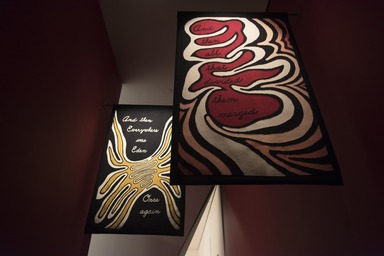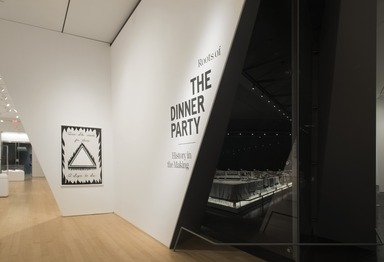

Roots of "The Dinner Party": History in the Making, October 20, 2017 through March 04, 2018 (Image: DIG_E_2017_Roots_of_the_Dinner_Party_01_PS11.jpg Brooklyn Museum photograph, 2017)

Roots of "The Dinner Party": History in the Making, October 20, 2017 through March 04, 2018 (Image: DIG_E_2017_Roots_of_the_Dinner_Party_02_PS11.jpg Brooklyn Museum photograph, 2017)
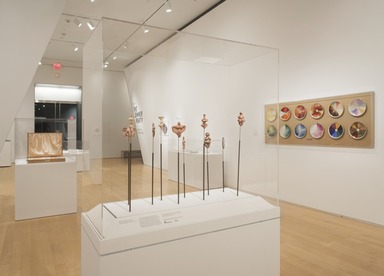
Roots of "The Dinner Party": History in the Making, October 20, 2017 through March 04, 2018 (Image: DIG_E_2017_Roots_of_the_Dinner_Party_03_PS11.jpg Brooklyn Museum photograph, 2017)

Roots of "The Dinner Party": History in the Making, October 20, 2017 through March 04, 2018 (Image: DIG_E_2017_Roots_of_the_Dinner_Party_04_PS11.jpg Brooklyn Museum photograph, 2017)
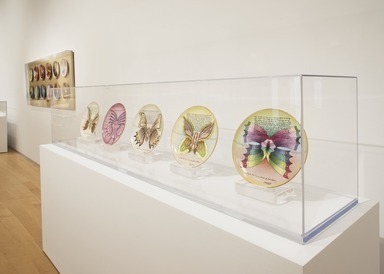
Roots of "The Dinner Party": History in the Making, October 20, 2017 through March 04, 2018 (Image: DIG_E_2017_Roots_of_the_Dinner_Party_05_PS11.jpg Brooklyn Museum photograph, 2017)

Roots of "The Dinner Party": History in the Making, October 20, 2017 through March 04, 2018 (Image: DIG_E_2017_Roots_of_the_Dinner_Party_06_PS11.jpg Brooklyn Museum photograph, 2017)

Roots of "The Dinner Party": History in the Making, October 20, 2017 through March 04, 2018 (Image: DIG_E_2017_Roots_of_the_Dinner_Party_08_PS11.jpg Brooklyn Museum photograph, 2017)

Roots of "The Dinner Party": History in the Making, October 20, 2017 through March 04, 2018 (Image: DIG_E_2017_Roots_of_the_Dinner_Party_09_PS11.jpg Brooklyn Museum photograph, 2017)
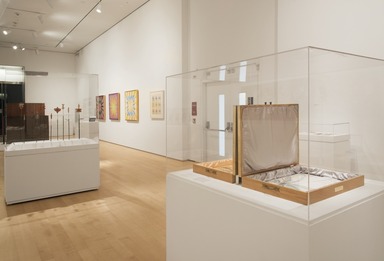
Roots of "The Dinner Party": History in the Making, October 20, 2017 through March 04, 2018 (Image: DIG_E_2017_Roots_of_the_Dinner_Party_10_PS11.jpg Brooklyn Museum photograph, 2017)
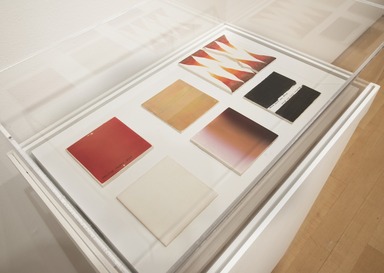
Roots of "The Dinner Party": History in the Making, October 20, 2017 through March 04, 2018 (Image: DIG_E_2017_Roots_of_the_Dinner_Party_11_PS11.jpg Brooklyn Museum photograph, 2017)

Roots of "The Dinner Party": History in the Making, October 20, 2017 through March 04, 2018 (Image: DIG_E_2017_Roots_of_the_Dinner_Party_12_PS11.jpg Brooklyn Museum photograph, 2017)
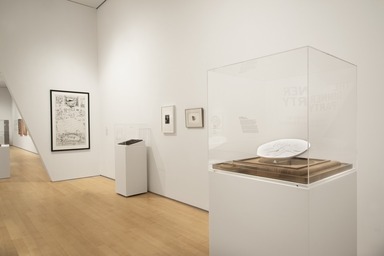
Roots of "The Dinner Party": History in the Making, October 20, 2017 through March 04, 2018 (Image: DIG_E_2017_Roots_of_the_Dinner_Party_13_PS11.jpg Brooklyn Museum photograph, 2017)

Roots of "The Dinner Party": History in the Making, October 20, 2017 through March 04, 2018 (Image: DIG_E_2017_Roots_of_the_Dinner_Party_14_PS11.jpg Brooklyn Museum photograph, 2017)
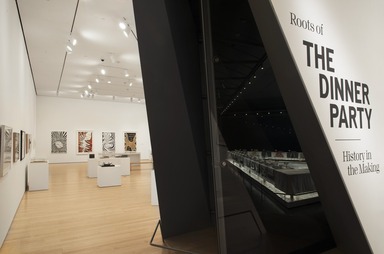
Roots of "The Dinner Party": History in the Making, October 20, 2017 through March 04, 2018 (Image: DIG_E_2017_Roots_of_the_Dinner_Party_15_PS11.jpg Brooklyn Museum photograph, 2017)

Roots of "The Dinner Party": History in the Making, October 20, 2017 through March 04, 2018 (Image: DIG_E_2017_Roots_of_the_Dinner_Party_16_PS11.jpg Brooklyn Museum photograph, 2017)

Roots of "The Dinner Party": History in the Making, October 20, 2017 through March 04, 2018 (Image: DIG_E_2017_Roots_of_the_Dinner_Party_17_PS11.jpg Brooklyn Museum photograph, 2017)

Roots of "The Dinner Party": History in the Making, October 20, 2017 through March 04, 2018 (Image: DIG_E_2017_Roots_of_the_Dinner_Party_18_PS11.jpg Brooklyn Museum photograph, 2017)

Roots of "The Dinner Party": History in the Making, October 20, 2017 through March 04, 2018 (Image: DIG_E_2017_Roots_of_the_Dinner_Party_19_PS11.jpg Brooklyn Museum photograph, 2017)

Roots of "The Dinner Party": History in the Making, October 20, 2017 through March 04, 2018 (Image: DIG_E_2017_Roots_of_the_Dinner_Party_20_PS11.jpg Brooklyn Museum photograph, 2017)
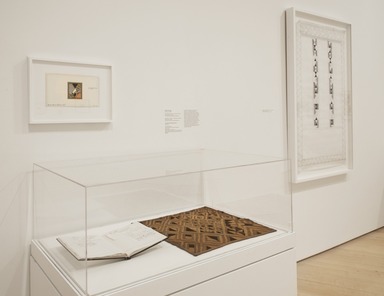
Roots of "The Dinner Party": History in the Making, October 20, 2017 through March 04, 2018 (Image: DIG_E_2017_Roots_of_the_Dinner_Party_21_PS11.jpg Brooklyn Museum photograph, 2017)
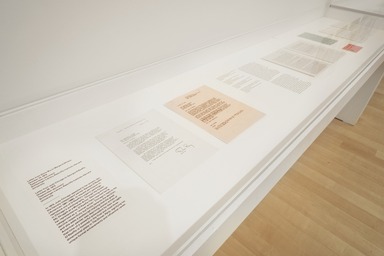
Roots of "The Dinner Party": History in the Making, October 20, 2017 through March 04, 2018 (Image: DIG_E_2017_Roots_of_the_Dinner_Party_22_PS11.jpg Brooklyn Museum photograph, 2017)

Roots of "The Dinner Party": History in the Making, October 20, 2017 through March 04, 2018 (Image: DIG_E_2017_Roots_of_the_Dinner_Party_23_PS11.jpg Brooklyn Museum photograph, 2017)
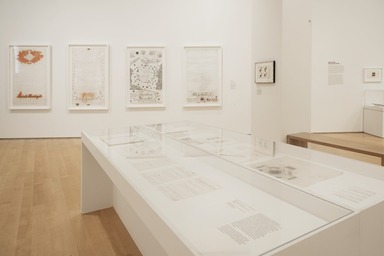
Roots of "The Dinner Party": History in the Making, October 20, 2017 through March 04, 2018 (Image: DIG_E_2017_Roots_of_the_Dinner_Party_24_PS11.jpg Brooklyn Museum photograph, 2017)
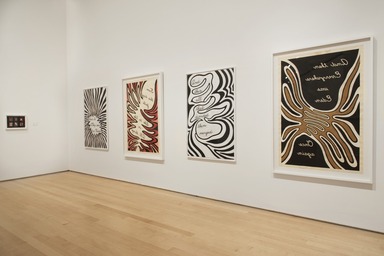
Roots of "The Dinner Party": History in the Making, October 20, 2017 through March 04, 2018 (Image: DIG_E_2017_Roots_of_the_Dinner_Party_25_PS11.jpg Brooklyn Museum photograph, 2017)
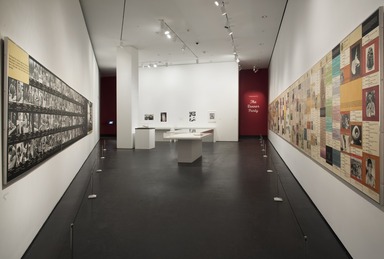
Roots of "The Dinner Party": History in the Making, October 20, 2017 through March 04, 2018 (Image: DIG_E_2017_Roots_of_the_Dinner_Party_26_PS11.jpg Brooklyn Museum photograph, 2017)
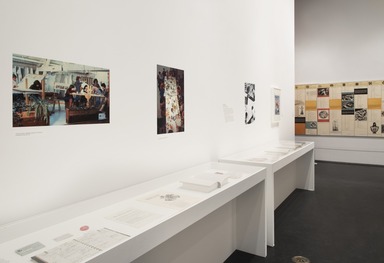
Roots of "The Dinner Party": History in the Making, October 20, 2017 through March 04, 2018 (Image: DIG_E_2017_Roots_of_the_Dinner_Party_27_PS11.jpg Brooklyn Museum photograph, 2017)
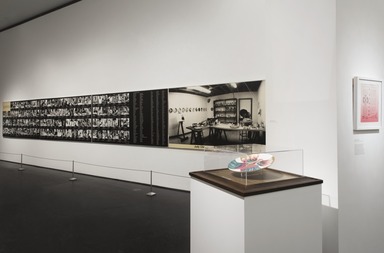
Roots of "The Dinner Party": History in the Making, October 20, 2017 through March 04, 2018 (Image: DIG_E_2017_Roots_of_the_Dinner_Party_28_PS11.jpg Brooklyn Museum photograph, 2017)
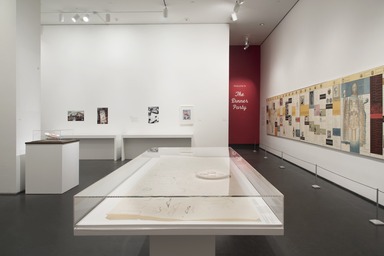
Roots of "The Dinner Party": History in the Making, October 20, 2017 through March 04, 2018 (Image: DIG_E_2017_Roots_of_the_Dinner_Party_29_PS11.jpg Brooklyn Museum photograph, 2017)
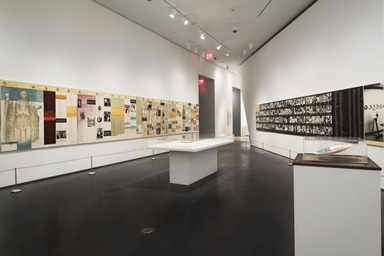
Roots of "The Dinner Party": History in the Making, October 20, 2017 through March 04, 2018 (Image: DIG_E_2017_Roots_of_the_Dinner_Party_30_PS11.jpg Brooklyn Museum photograph, 2017)

Roots of "The Dinner Party": History in the Making, October 20, 2017 through March 04, 2018 (Image: DIG_E_2017_Roots_of_the_Dinner_Party_31_PS11.jpg Brooklyn Museum photograph, 2017)
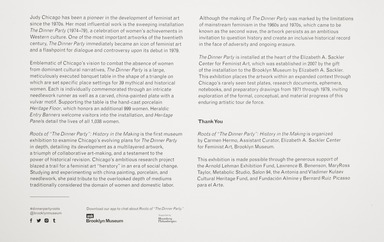
Roots of "The Dinner Party": History in the Making, October 20, 2017 through March 04, 2018 (Image: DIG_E_2017_Roots_of_the_Dinner_Party_32_PS11.jpg Brooklyn Museum photograph, 2017)

Roots of "The Dinner Party": History in the Making, October 20, 2017 through March 04, 2018 (Image: DIG_E_2017_Roots_of_the_Dinner_Party_33_PS11.jpg Brooklyn Museum photograph, 2017)
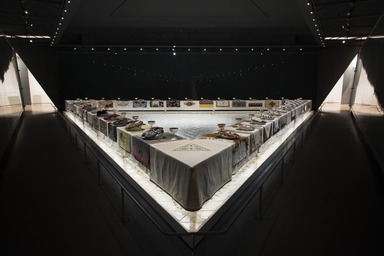
Roots of "The Dinner Party": History in the Making, October 20, 2017 through March 04, 2018 (Image: DIG_E_2017_Roots_of_the_Dinner_Party_34_PS11.jpg Brooklyn Museum photograph, 2017)
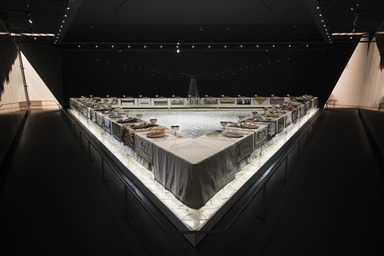
Roots of "The Dinner Party": History in the Making, October 20, 2017 through March 04, 2018 (Image: DIG_E_2017_Roots_of_the_Dinner_Party_35_PS11.jpg Brooklyn Museum photograph, 2017)
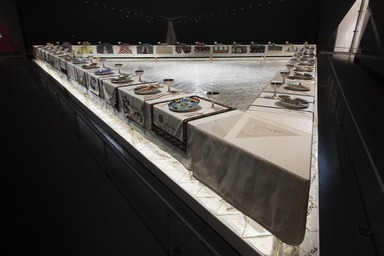
Roots of "The Dinner Party": History in the Making, October 20, 2017 through March 04, 2018 (Image: DIG_E_2017_Roots_of_the_Dinner_Party_36_PS11.jpg Brooklyn Museum photograph, 2017)
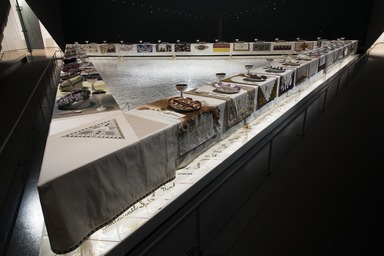
Roots of "The Dinner Party": History in the Making, October 20, 2017 through March 04, 2018 (Image: DIG_E_2017_Roots_of_the_Dinner_Party_37_PS11.jpg Brooklyn Museum photograph, 2017)
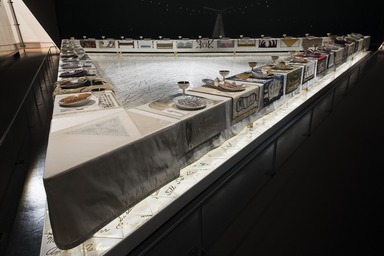
Roots of "The Dinner Party": History in the Making, October 20, 2017 through March 04, 2018 (Image: DIG_E_2017_Roots_of_the_Dinner_Party_38_PS11.jpg Brooklyn Museum photograph, 2017)

Roots of "The Dinner Party": History in the Making, October 20, 2017 through March 04, 2018 (Image: DIG_E_2017_Roots_of_the_Dinner_Party_39_PS11.jpg Brooklyn Museum photograph, 2017)

Roots of "The Dinner Party": History in the Making, October 20, 2017 through March 04, 2018 (Image: DIG_E_2017_Roots_of_the_Dinner_Party_40_PS11.jpg Brooklyn Museum photograph, 2017)
Roots of "The Dinner Party": History in the Making
-
Roots of "The Dinner Party": History in the Making
Judy Chicago has been a pioneer in the development of feminist art since the 1970s. Her most influential work is the sweeping installation The Dinner Party (1974–79), a celebration of women’s achievements in Western culture. One of the most important artworks of the twentieth century, The Dinner Party immediately became an icon of feminist art and a flashpoint for dialogue and controversy upon its debut in 1979.
Emblematic of Chicago’s vision to combat the absence of women from dominant cultural narratives, The Dinner Party is a large, meticulously executed banquet table in the shape of a triangle on which are set specific place settings for 39 mythical and historical women. Each is individually commemorated through an intricate needlework runner as well as a carved, china-painted plate with a vulvar motif. Supporting the table is the hand-cast porcelain Heritage Floor, which honors an additional 999 women. Heraldic Entry Banners welcome visitors into the installation, and Heritage Panels detail the lives of all 1,038 women.
Roots of “The Dinner Party”: History in the Making is the first museum exhibition to examine Chicago’s evolving plans for The Dinner Party in depth, detailing its development as a multilayered artwork, a triumph of collaborative art-making, and a testament to the power of historical revision. Chicago’s ambitious research project blazed a trail for a feminist art “herstory” in an era of social change. Studying and experimenting with china painting, porcelain, and needlework, she paid tribute to the overlooked depth of mediums traditionally considered the domain of women and domestic labor.
Although the making of The Dinner Party was marked by the limitations of mainstream feminism in the 1960s and 1970s, which came to be known as the second wave, the artwork persists as an ambitious invitation to question history and create an inclusive historical record in the face of adversity and ongoing erasure.
The Dinner Party is installed at the heart of the Elizabeth A. Sackler Center for Feminist Art, which was established in 2007 by the gift of the installation to the Brooklyn Museum by Elizabeth A. Sackler. This exhibition places the artwork within an expanded context through Chicago’s rarely seen test plates, research documents, ephemera, notebooks, and preparatory drawings from 1971 through 1979, inviting exploration of the formal, conceptual, and material progress of this enduring artistic tour de force.
Thank You
Roots of “The Dinner Party”: History in the Making is organized by Carmen Hermo, Assistant Curator, Elizabeth A. Sackler Center for Feminist Art, Brooklyn Museum.
This exhibition is made possible through the generous support of the Arnold Lehman Exhibition Fund, Lawrence B. Benenson, MaryRoss Taylor, Metabolic Studio, Salon 94, the Antonia and Vladimer Kulaev Cultural Heritage Fund, and Fundación Almine y Bernard Ruiz-Picasso para el Arte. -
Roots of "The Dinner Party" Year of Yes
Roots of “The Dinner Party”: History in the Making is part of A Year of Yes: Reimagining Feminism at the Brooklyn Museum, a yearlong series of exhibitions celebrating the 10th anniversary of the Elizabeth A. Sackler Center for Feminist Art. Leadership support is provided by Elizabeth A. Sackler, the Ford Foundation, the Stavros Niarchos Foundation, Anne Klein, the Calvin Klein Family Foundation, the Institute of Museum and Library Services, Mary Jo and Ted Shen, and an anonymous donor. Generous support is also provided by Annette Blum, the Taylor Foundation, the Antonia and Vladimer Kulaev Cultural Heritage Fund, Beth Dozoretz, and The Cowles Charitable Trust. -
Before The Dinner Party
Struggling to gain acceptance from her peers in the male-dominated art world, and feeling invisible in the face of male-centric art history, Chicago pursued her career in tandem with a growing urge to use her art to explore her experiences as a woman. Chicago matured as an artist in the 1960s, and by the early 1970s had established her visual language using Minimalist forms and vivid colors. Working in Fresno, California, and then Los Angeles, she then developed an abstract formal language that evoked this struggle, and established a radical educational practice—the Feminist Art Program—that trained women to become confident professional artists. Embarking on a mission to uncover a lineage of women artists, Chicago wanted to understand women’s herstory, which was the generative basis of The Dinner Party.
While working on her Great Ladies series, Chicago spent two years studying the techniques and artistic possibilities of china painting and ceramics. Having worked with industrial techniques in the previous decade, Chicago turned to mediums that had been traditionally associated with “women’s work,” aligning with her desire to see women’s experiences reflected in art and culture at large. Chicago began the process of unlearning internalized gender biases regarding these mediums, while expanding her visual language of organic, butterfly- and vulva-inspired forms. -
Plates: Symbolism and Struggle
The conception of The Dinner Party grew from Chicago’s desire to know and represent women’s experience within a large, complex, and comprehensive artwork reimagining Western history as it had commonly been taught. Chicago balanced the development of a visual language specific to The Dinner Party and its new perspective on history with her material inquiry—especially the difficult trial-and-error process of china painting ceramic plates. In the work, each detail either conveys a symbolic meaning based on women’s oppression or erasure from history, or directly alludes to the historical conditions and lives of the 39 women honored in the unique place settings.
A major motif throughout the plates is Chicago’s central-core imagery—often in a vulvar-butterfly form—intended to symbolize female freedom and growth. This motif has been criticized as reducing the varied experiences of the women in The Dinner Party to their shared biology. For some, the central-core imagery over-emphasizes a binary division between men and women, reinforcing the idea that genitalia determine identity and experience. One of The Dinner Party’s most potent metaphors is the three-dimensionality of the plates themselves; their escalating heights represent the growing struggle for equality and change over time. Carving, sculpting, and painting these plates proved a trying process, and it took Chicago nearly a year and a half to settle on the plate size, porcelain type, glaze, and firing process, as the scope of The Dinner Party continued to grow. -
Form, Content, and Critique
The Dinner Party was envisioned to be widely accessible, as Chicago believed that an artwork could impart information as well as inspiration. Developing the designs of the unique plates and needlework runners involved numerous sketches that combined Chicago’s artistic vision and factual research. Collecting, organizing, and visually tracing the specific trials and social pressures of 39 figures served to repopulate Western history with women. Ultimately, however, the artwork left that history’s focus on heroic individuals, as well as its racial and class biases, in place.
Sojourner Truth (American, c. 1797–1883) is the only African American woman honored in the 39 place settings, though black activists and artists are counted among the Heritage Floor’s 999 names. The representation of the women’s rights activist and prominent abolitionist was the subject of criticism as soon as The Dinner Party opened to the public in 1979, as Truth is not depicted with the vulvar motif that marks most of the other place settings, but in a figurative mode. Many critiqued this perceived denial of black women’s sexuality as a sign of the larger failures of second-wave feminism to allow for authentic images of black experience. For Chicago, featuring Truth in a prominent place in Western history symbolized an important step forward; for many viewers, however, Truth’s tokenized inclusion represented a step backward.
This debate highlights how a binary view of gender was the main current of feminist thought engaged by The Dinner Party, while nuances of class, race, sexuality, and gender essentialism go largely unexplored in the work. -
Needlework: Process and History
Embroidered needlework runners enabled Chicago to add nuance and depth to each woman’s place setting in The Dinner Party, beyond the abstract imagery on the plates, and to further represent each woman’s historical circumstances. Chicago took inspiration from medieval Christianity, which used art and iconography to educate its then largely illiterate followers; by extending that precedent and updating it for the 1970s, when the general public knew almost nothing about the role of women in history, Chicago attempted, with The Dinner Party, to provide education through art.
Each runner is based on research and reflection on how to represent the social environment of the woman. Due to the runners’ complexity, the needlework loft was the busiest area of The Dinner Party studio. Chicago’s drawings and color choices were executed and embellished by the skilled or newly trained needlework volunteers. The studio developed a new needlework frame type that allowed workers to see their compositions upright and in full, rather than piece by piece, as the medium’s intimate and domestic history prescribed. As with china painting, Chicago worked to add visual rigor and symbolic meaning to a technique that had been used for decorative purposes and denied art-historical recognition. -
Expanding the Studio and The Dinner Party's Scope
Judy Chicago intended The Dinner Party to be so vast and impressive that women could never again be erased from history; this lofty objective required rigorous research. Beginning in March 1977, the project expanded beyond close collaborators, drawing more than 400 women and men to Santa Monica to finish the artwork in 1979. The studio volunteers worked to overcome the dearth of information on women’s achievements, assembling biographical data and illustrative anecdotes to help Chicago visually imagine each historical and mythical woman on the artist’s own terms. Chicago was also influenced by the broader feminist movement, exchanging ideas with a growing network of informed activists, academics, artists, authors, and community members.
From a pool of 3,000 names, Chicago and her collaborators conceived of a rubric to determine the 999 women to honor on the Heritage Floor. Their research led to the division of The Dinner Party into its three wings: from prehistory to Rome, from Christianity to the Reformation, and from the American Revolution to the women’s revolution. By working within the established historical narrative of Western culture, however, The Dinner Party also implicitly reinforced the biased framework of this history: wealthy ruling-class white women hold privileged places at the table, Native American and Latina women appear in relation to colonial histories, and African American experience is limited to its association with slavery in the United States. Still, for many, The Dinner Party marked the first time so many women were seen as integral to the trajectory of Western civilization, and the first time this then-monolithically male history had been so publicly and powerfully called into question. -
Judy Chicago on The Dinner Party's Brooklyn Homecoming
My goal for The Dinner Party, from its inception, was to have it permanently housed, as I recognized that this was the only way for the work to overcome the erasure of women’s history that it recounts. But I had no idea what a long and torturous journey this would involve, including watching the piece being “debated” by a group of angry congressmen in Washington, D.C., who stepped in to prevent The Dinner Party from being permanently housed in an institution there. Over the years, many groups organized to try to achieve a permanent home for the work, but they were as naive as I was in terms of what a permanent installation actually involved.
Finally, through the vision of Elizabeth Sackler, The Dinner Party came back to Brooklyn—where it had traveled in 1980–81 on its international tour—as the centerpiece of the Elizabeth A. Sackler Center for Feminist Art. This long story with a happy ending proves the point that one woman can make a big difference. This point is also made by the empowering stories of the 1,038 women represented in the work. But The Dinner Party is intended as a symbol of women’s history; as such, it merely suggests the thousands of untold stories and unsung heroines who deserve attention, honor, and a place at the table. -
Judy Chicago on Sor Juana Inés de la Cruz
Over the years, I have often been asked if I would change anything about The Dinner Party. My only regret has to do with the limits of scholarship when I was doing my original research for the women on the table. One of the women who interested me was Sor Juana Inés de la Cruz, who, like Anna van Schurman, was a genius at a time when female genius was considered an impossibility. While still a teenager, Sor Juana became known for both her poetry and her erudition. In order to pursue her intellectual interests, she reluctantly took religious vows, because convents were one of the few places that provided a supportive environment for educated women. Unfortunately, she became a target of the Inquisition, and her four-thousand-book library was burned and her musical instruments and scientific equipment confiscated.
One of my criteria for inclusion in The Dinner Party was that the woman had to be a role model for the future. Until recently, I did not know that Sor Juana continued writing in secret, thereby refusing to surrender to the pressure of the Inquisition. Although such courage would certainly have qualified her for an individual place setting, I selected Anna van Schurman, thinking that she better represented the consequences women faced if they challenged prevailing ideas about women’s social place or argued for women’s right to education, as both she and Sor Juana did. However, I realize now that even though van Schurman’s circumstances were constrained, Sor Juana Inés de la Cruz would probably have been a better choice; still, Sor Juana’s achievements are acknowledged by her place on the Heritage Floor. -
Judy Chicago on Mary Wollstonecraft and the Dawn of Modern Feminism
In my ongoing study of women’s history, I discovered that some of the cultural changes that have been viewed as progress have benefited men but not women. During the French Revolution, the concept of democracy that was in the air applied to men only, though many women did not realize this, including Mary Wollstonecraft, who looked to the events in France to bring about the emancipation of women. However, the phrase “liberty, equality, fraternity” that is associated with this period meant exactly that: brotherhood.
It fell to Wollstonecraft to argue in A Vindication of the Rights of Woman that democracy must be extended to women; if women failed to become men’s equals, the progress of human knowledge and development would be halted. Vilified as a “hyena in petticoats,” Wollstonecraft did not live to see the revolutionary impact of her vision. Though feminist arguments dated back to the Renaissance, her book established the foundation of modern feminism.
When I was working on The Dinner Party, Wollstonecraft’s groundbreaking eighteenth-century treatise had not even been updated to reflect modern English usage and style. Even today, her work is rarely taught as part of the history of philosophy, even though her ideas apply to half the human race. -
Setting the Table
To achieve The Dinner Party’s dazzling and dramatic installation, the 39 plates and embroidered runners are presented on the immense hand-cast porcelain Heritage Floor. It names 999 additional women, grouped to symbolize the long herstory of achievement represented by each place setting. Hand-embroidered napkins, golden ceramic chalices, and lustrous cutlery accent each place setting, all of which were produced by the studio. Entry Banners designed by Chicago and featuring her poem were woven by studio workers to lead viewers into the space and convey a hope for equality and a dream of female power. Large panels documenting the studio volunteers and the historical lineage of women in The Dinner Party accompanied the work, ensuring credit for all those who contributed and providing greater context; the panels are installed in the adjacent Herstory Gallery. -
Debut and Tour
Despite outrage from the American popular press (who railed against the work’s supposedly pornographic content) and dismissal by most mainstream art critics (who thought the work too kitschy or informational to be considered art), The Dinner Party was wildly popular, with its exhibition at the San Francisco Museum of Modern Art attracting a record-breaking 100,000 visitors. The controversies that followed the work’s debut, however, led to the breakdown of the anticipated museum tour.
As a result, volunteers, with the help of The Dinner Party Project Coordinator Diane Gelon, sprang into action, finding nontraditional venues and mobilizing local feminist and women’s rights groups for support. Modeled after the collective energy of The Dinner Party studio, a vast network of women was empowered to engage their communities, prepare installation spaces, and raise funds to cover the cost of the work’s display across fourteen venues and three continents. Through local activism and fundraising efforts in New York, the Brooklyn Museum became the only other U.S. museum to display The Dinner Party, in 1980–81, where its exhibition exceeded expectations by attracting large crowds. -
Judy Chicago on Finding the 1,038 Women
In the late 1960s, I was lecturing frequently on my work and, wherever I traveled, sought out used bookstores where I found—for one dollar a volume—dozens of books on women’s history, because there was so little interest in it. Out of this self-guided study, I discovered my heritage and set out to create a work of art that would educate a broad and diverse audience. I assembled a card file on 300 women, and from this group I began to select the women at the table. After I decided to place the table on a porcelain floor, I realized that I needed a resource of 3,000 names. A young art-history student named Diane Gelon volunteered for the job, starting as a researcher and eventually becoming The Dinner Party’s coordinator and tour administrator.
Eventually, we assembled a rather ragtag but dedicated research team led by an artist named Ann Isolde (no professional historians were interested), who worked for several years to achieve my goal. Diane and I had to train the team to select the nuggets of information on women buried in the histories of their husbands, brothers, or sons. It is hard to convey the excitement in the air when we finally sat down together to select the 999 names for the Heritage Floor (I decided on that number because of its biblical ring). Using a set of criteria we had devised, we made history (or herstory) together, a process from which women have generally been excluded. It was such fun. -
Judy Chicago on Sojourner Truth
In 1843, Sojourner Truth discarded the name given to her when she was enslaved and selected ‘‘Sojourner’’ because sojourn means ‘‘to dwell temporarily,’’ which she thought an apt description of life. ‘‘Truth’’ was the message she intended to carry to the world, a truth she had lived in the intertwining of race and gender that defined her painful experiences. Her early recognition of what is now called intersectionality is one of the reasons I included Truth in The Dinner Party. Over a century after she changed her name, I changed my own name as a way of symbolizing my decision to create a feminist art practice, a concept that was unknown in the early 1970s.
Knowing about women like Truth helped me withstand some of the misunderstanding and misrepresentation that has often greeted me and my work. I would think about her famous speech at the 1851 Women’s Rights Convention in Akron, Ohio, and feel strengthened by her words: ‘‘Look at me,’’ she demanded, as recounted in reports after her speech, ‘‘Look at my arm, it’s plowed and planted and gathered into barns and no man could head me—and ain’t I a woman?’’ She bravely articulated a sense of self that the world couldn’t perceive, one that insisted on her worth as a human being, a perception of women that is sadly lacking in too many parts of the world.
-
June 28, 2017
The exhibition concludes A Year of Yes: Reimagining Feminism at the Brooklyn Museum
October 20, 2017–March 4, 2018
Roots of “The Dinner Party”: History in the Making is the first museum exhibition to examine the formal, material, and conceptual development of Judy Chicago’s feminist artwork The Dinner Party (1974–79)—the artist’s most influential work and a signature highlight of the Brooklyn Museum’s permanent collection. From October 20, 2017, through March 4, 2018, the exhibition presents never-before-seen objects that illuminate the installation’s development as a multilayered artwork, a triumph of collaborative art-making, and a testament to the power of revising Western history to include women. Roots of “The Dinner Party” is the final exhibition in A Year of Yes: Reimagining Feminism at the Brooklyn Museum, the Museum-wide series of exhibitions that present voices from the history of feminism and feminist art in celebration of the 10th anniversary of the Elizabeth A. Sackler Center for Feminist Art.
Presented in the Elizabeth A. Sackler Center for Feminist Art, alongside The Dinner Party, the exhibition features more than 100 objects, including rarely seen test plates, research documents, ephemera, notebooks, and preparatory drawings from 1971 through 1979. The exhibition is presented chronologically, with sections introducing Chicago’s vision for The Dinner Party and her material study of China-painting, porcelain, and needlework—including focused case studies of the Mary Wollstonecraft and Sojourner Truth place settings. It continues with research documents and ephemera from Chicago’s studio, highlighting the workshop and research project behind the artwork, and its eventual worldwide tour. Roots of “The Dinner Party” adds depth and context to the visitor’s experience of The Dinner Party, revealing the thought process, creative evolution, and history behind the work, while unpacking some of the misperceptions surrounding this controversial artwork and its critical reception.
Exhibition curator Carmen Hermo, Assistant Curator of the Elizabeth A. Sackler Center for Feminist Art, remarks: “The Dinner Party is a milestone in the art of the last century, and continues to inspire and inform those who come to see it at the Brooklyn Museum, read about it in art history books, or use it as a model for questioning history. This signature piece in our collection is a vital resource for sparking conversation about feminism, political art, and diverse representation.”
About The Dinner Party by Judy Chicago
The Dinner Party by Judy Chicago was created to rectify the absence of women from the dominant Western historical narrative, while also reestablishing the importance of materials and techniques like ceramics, China-painting, and textiles, traditionally considered the domain of women and domestic labor. Chicago involved nearly 400 women and men in a vast studio workshop to complete the installation. The Dinner Party comprises a massive ceremonial banquet, arranged on a triangular table with a total of thirty-nine place settings, each commemorating an important historical or mythical woman. The settings reflect the life of each honored woman, and consist of embroidered runners, gold chalices and utensils, and China-painted porcelain plates with motifs based on vulvar and butterfly forms. The names of another 999 women are inscribed in gold on the white tile floor below the triangular table, symbolizing the long history of achievement represented by each place setting.
After five years of work and preparation, The Dinner Party debuted at the San Francisco Museum of Modern Art in 1979, drawing in approximately one hundred thousand people during its three months on view. For many, the artwork’s alternative view of Western history and culture marked the first time they learned of the achievements and experiences of the 1,038 women named in the artwork. Despite its popular appeal, The Dinner Party was controversial, with some perceiving it to be pornographic and kitschy. Critics also argued that the work marginalizes women of color, reflecting the biases of the largely white and middle-class second-wave feminist movement.
After its debut in San Francisco, The Dinner Party went on a nine-year tour to fourteen international venues as a result of fundraising and planning by local communities. Each exhibition of the work attracted large crowds and continued the public conversation about feminism and history that Chicago sought to visualize through her artwork. Still, The Dinner Party struggled to find a permanent home, which was Chicago’s goal from the beginning. The work faced an ambiguous future until Elizabeth A. Sackler acquired the work in 2001 and gifted it to the Brooklyn Museum in 2002. The Elizabeth A. Sackler Center for Feminist Art opened in 2007 with The Dinner Party as its foundation.
About Judy Chicago
Judy Chicago is internationally known as one of the pioneers in promoting and articulating a feminist approach to art-making. She initiated feminist art and education in the early 1970s through unique programs for women artists at California State University-Fresno and, later (with Miriam Schapiro), at the California Institute of the Arts. Chicago is the recipient of innumerable grants, awards, and honorary degrees from prestigious colleges and universities, and her work is in the collections of numerous museums, including the Tate Modern; The British Museum; Brooklyn Museum; Los Angeles County Museum of Art; Museum of Fine Arts, Santa Fe; National Museum of Women in the Arts; San Francisco Museum of Modern Art; and Crystal Bridges Museum of American Art, among others. Her career as an artist, author, and educator spans five decades.
Speaking about her mission to create The Dinner Party as a way to teach and honor women’s history, Chicago states: “Because we are denied knowledge of our history, we are deprived of standing upon each other’s shoulders and building upon each other’s hard-earned accomplishments. Instead we are condemned to repeat what others have done before us, and thus we continually reinvent the wheel. The goal of The Dinner Party is to break this cycle.”
About the Elizabeth A. Sackler Center for Feminist Art
The Elizabeth A. Sackler Center for Feminist Art is a nexus for feminist art, theory, and activism. It is the permanent home of The Dinner Party by Judy Chicago, its Feminist Art and Herstory galleries display critically acclaimed exhibitions, and its Forum is a venue for lectures and a platform for advocacy for women’s issues.
On Thursday, October 19, 2017, the Brooklyn Museum honors Judy Chicago at the inaugural Yes! Gala and will celebrate the 10th anniversary of the Elizabeth A. Sackler Center for Feminist Art and the past, present, and future of feminist art. The benefit also honors this year’s Sackler Center First Awardees—eleven women who have paved the way for future generations.
Press Area of Website
View Original

